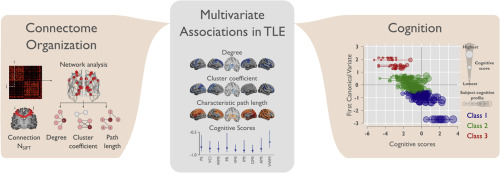当前位置:
X-MOL 学术
›
NeuroImage
›
论文详情
Our official English website, www.x-mol.net, welcomes your
feedback! (Note: you will need to create a separate account there.)
Multidimensional associations between cognition and connectome organization in temporal lobe epilepsy
NeuroImage ( IF 4.7 ) Pub Date : 2020-06-01 , DOI: 10.1016/j.neuroimage.2020.116706 Raúl Rodríguez-Cruces 1 , Boris C Bernhardt 2 , Luis Concha 3
NeuroImage ( IF 4.7 ) Pub Date : 2020-06-01 , DOI: 10.1016/j.neuroimage.2020.116706 Raúl Rodríguez-Cruces 1 , Boris C Bernhardt 2 , Luis Concha 3
Affiliation

|
OBJECTIVE
Temporal lobe epilepsy (TLE) is known to affect large-scale structural networks and cognitive function in multiple domains. The study of complex relations between structural network organization and cognition requires comprehensive analytical methods and a shift towards multivariate techniques. Here, we sought to identify multidimensional associations between cognitive performance and structural network topology in TLE. METHODS
We studied 34 drug-resistant adult TLE patients and 24 age- and sex-matched healthy controls. Participants underwent a comprehensive neurocognitive battery and multimodal MRI, allowing for large-scale connectomics, and morphological evaluation of subcortical and neocortical regions. Using canonical correlation analysis, we identified a multivariate mode that links cognitive performance to a brain structural network. Our approach was complemented by bootstrap-based hierarchical clustering to derive cognitive subtypes and associated patterns of macroscale connectome anomalies. RESULTS
Both methodologies provided converging evidence for a close coupling between cognitive impairments across multiple domains and large-scale structural network compromise. Cognitive classes presented with an increasing gradient of abnormalities (increasing cortical and subcortical atrophy and less efficient white matter connectome organization in patients with increasing degrees of cognitive impairments). Notably, network topology characterized cognitive performance better than morphometric measures did. CONCLUSIONS
Our multivariate approach emphasized a close coupling of cognitive dysfunction and large-scale network anomalies in TLE. Our findings contribute to understand the complexity of structural connectivity regulating the heterogeneous cognitive deficits found in epilepsy.
中文翻译:

颞叶癫痫认知与连接组组织的多维关联
目的 众所周知,颞叶癫痫 (TLE) 会影响多个领域的大规模结构网络和认知功能。结构网络组织与认知之间复杂关系的研究需要综合分析方法和向多元技术的转变。在这里,我们试图确定 TLE 中认知表现和结构网络拓扑之间的多维关联。方法 我们研究了 34 名耐药成人 TLE 患者和 24 名年龄和性别匹配的健康对照。参与者接受了全面的神经认知电池和多模式 MRI,允许进行大规模的连接组学以及皮质下和新皮质区域的形态学评估。使用典型相关分析,我们确定了一种将认知表现与大脑结构网络联系起来的多元模式。我们的方法得到了基于引导程序的层次聚类的补充,以推导出认知亚型和宏观连接组异常的相关模式。结果 两种方法都为跨多个领域的认知障碍与大规模结构网络妥协之间的密切耦合提供了汇聚证据。认知类别呈现出越来越多的异常梯度(在认知障碍程度越来越高的患者中,皮质和皮质下萎缩增加,白质连接组组织效率降低)。值得注意的是,网络拓扑比形态测量更能表征认知性能。结论我们的多变量方法强调了 TLE 中认知功能障碍和大规模网络异常的密切耦合。我们的研究结果有助于理解调节癫痫中发现的异质认知缺陷的结构连接的复杂性。
更新日期:2020-06-01
中文翻译:

颞叶癫痫认知与连接组组织的多维关联
目的 众所周知,颞叶癫痫 (TLE) 会影响多个领域的大规模结构网络和认知功能。结构网络组织与认知之间复杂关系的研究需要综合分析方法和向多元技术的转变。在这里,我们试图确定 TLE 中认知表现和结构网络拓扑之间的多维关联。方法 我们研究了 34 名耐药成人 TLE 患者和 24 名年龄和性别匹配的健康对照。参与者接受了全面的神经认知电池和多模式 MRI,允许进行大规模的连接组学以及皮质下和新皮质区域的形态学评估。使用典型相关分析,我们确定了一种将认知表现与大脑结构网络联系起来的多元模式。我们的方法得到了基于引导程序的层次聚类的补充,以推导出认知亚型和宏观连接组异常的相关模式。结果 两种方法都为跨多个领域的认知障碍与大规模结构网络妥协之间的密切耦合提供了汇聚证据。认知类别呈现出越来越多的异常梯度(在认知障碍程度越来越高的患者中,皮质和皮质下萎缩增加,白质连接组组织效率降低)。值得注意的是,网络拓扑比形态测量更能表征认知性能。结论我们的多变量方法强调了 TLE 中认知功能障碍和大规模网络异常的密切耦合。我们的研究结果有助于理解调节癫痫中发现的异质认知缺陷的结构连接的复杂性。











































 京公网安备 11010802027423号
京公网安备 11010802027423号